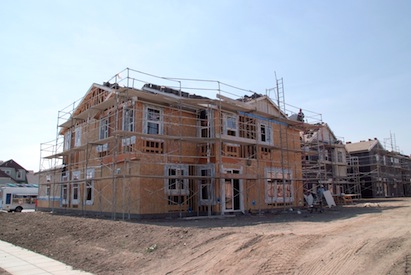Last year, Professional Builder Publisher Patrick O’Toole asked me to write on quality management. In his travels around the country, Pat was hearing from builders that quality, which took a backseat during the darkest years of the housing recession, was coming back strong as an important issue. I knew it would be difficult to fit everything into one article, and that first piece soon grew into three and then five. Those first five articles covered the evolution of quality, a vision for the future, the elements to achieve that vision, a lament on the current state of quality, and the street-level tactics for restoring quality at the site level. One might think I had covered it all, but while preparing for a presentation at this year’s Benchmark Conference, I realized there was a gap between establishing quality as a business strategy and getting down to tactics for delivering quality in the field.
Most builders understand, at least intellectually, that providing a high level of quality is no longer merely a choice; quality is a customer requirement. Table stakes. Yet when challenged to provide that quality, most builders focus on the back end, leaning on field superintendents to have the homes 100 percent ready, and on the warranty techs to fix anything after possession both quickly and well. Those are important, of course, but the secret of the very best builders is they do things so well throughout the entire process from day one that the burden on superintendents and service drops dramatically, enabling all to do their jobs far better and deliver top quality. Here is what it looks like:
1. Leadership and commitment—The Quality Culture
I have worked with more than 200 builders in my career on quality-related product and process issues, and in the past six years with more than 75 on Lean Process implementations, which are inextricably tied to quality. I am frequently asked to name the single most important factor to build and maintain a quality organization—the kind that consistently produces a quality product at a strong profit. I can state unequivocally that in my experience in more than 35 states, Canada, Australia, and Mexico, the answer is the same: senior management leadership and commitment. If the head fully “gets it,” the body always comes around. Can you turn the body and drag the head around with it? It is possible, but incredibly difficult with a high failure rate. Fifteen years ago I wrote an article on this titled, with homage to James Carville, “It’s the culture, stupid!” Nothing whatsoever has changed. If you are having quality issues, the ultimate source is always leadership.
2. System capacity meets construction complexity
Strong systems and processes are critical, yet I frequently find builders at a loss as to why no one can keep up. The problem is complexity, which without continual discipline always grows to exceed capacity in either volume or product variation or both. Thus, back-office departments including accounting, purchasing, and design are locked in an eternal scramble to keep up while field superintendents and warranty techs run around with their hair on fire. Quality suffers. Build great systems and processes and resist the urge to let options and changes proliferate. Set up your cut-off dates and train your sales people to manage the customers to them. Then constantly monitor for signs that complexity is pushing capacity to its limit, get proactive, and maintain the process. Dr. Deming, the late great quality guru, is quoted in his younger years as saying, “Variation is the enemy of quality.” In his later years, he modified that to say, “Uncontrolled variation is the enemy of quality.” So control it, or live with the consequences.
3. Build what you know and be the best
During the worst years of the housing recession, the temptation and perhaps even the need was to go after any deal that held hope for even a small profit. Yet from autos to airplanes to healthcare to homes, those who prosper learn to do a few things—maybe even one thing—extremely well, and better than anyone else. Those who chase whatever walks in the door or what sticks to the wall never get to be the best at anything, and they pay for it in quality and margin. Back in the “golden years,” from about 1991 through 2006, most builder profit was made from a combination of three things: land appreciation, sales price inflation, and volume expansion. Throw something up, anything, and there was a buyer no matter what the quality or value. Those days are gone for 98 percent of you. So look for the intersection of four things: what you do really well, what you truly enjoy building, what your market needs, and what you can profitably build. Do this better than anyone else, and buyers will be there for you.
4. Product drives land
Homebuilding remains primarily a deal game for many builders, and the impact on quality is profound. A tract of land or a group of lots walks in the front door and the only thing that matters is price, terms, and clear title. The boss buys it then tosses it over the wall to marketing and design, who ask, “What are we going to build on this?” The boss says, “Pull out those old Heritage Townhomes from 1998, the ones we built in Central City, but put them on slabs, skinny up the garage, drop the back porch, whip up a few new elevations, and you are good to go! Oh, wait. Fix those stairs, the customers hated that they could not get a queen-size mattress up them and that stacked washer-dryer combo did not work...and get the cost out. We never made money on those.” Then purchasing spends a couple of frantic months trying to make this mess work with suppliers and trades who have not built townhomes before. Finally, construction walks out the back door wondering how they are going to build this and stay on schedule, and warranty spends all their time fixing it. I learned this 25 years ago from Steve Burch, now national marketing VP for Pulte Homes. First establish your core building competencies, and then go find the land to fit. Not the other way around. Your life, and your quality, will be much better.
5. Design for quality
When we think “design” we think almost exclusively about the look. How cool is it? Is it authentic? What is the curb appeal? How does the plan flow? Does the kitchen grab you? All of those are important; but to enable quality, we look at a side of design that most do not consider. What is the “constructability” of this plan? How easy or hard is it to build? Are the dimensions calculated to minimize waste in time and material? Is it full of little traps that create rework, extra trips to the site, and excess supervision? I hear all the time from builders how some plans and models just seem easy to build and come out great while others are a mess, but they rarely explore the reasons why. I suggest you do that and create detailed design standards citing what you will and won’t build and how to design so it builds well. From the first bid until the last adjustment prior to close, everything will improve.
6. Complete plans and specifications
If you don’t provide your suppliers and trades with 100-percent complete plans and specifications to both bid and build from, you are costing yourself time, money and quality. Period. No excuses. Do we really need to debate this any longer? Does anyone still believe you save one cent by not providing a fully reversed plan to your trades, to cite just one of a long list of inadequacies? If you don’t know what constitutes truly complete plans and specs, go to your lumber company and beg them to show you a set from their best builder. Now you know. Hire the right guy and get started. Watch your quality issues begin to shrink.
7. Strong field operations
This is the most obvious element, but it cannot be overstated. It is nearly impossible to put too much effort into finding good people and training them well. Two warnings, however. You cannot build your company on the backs of heroes, and you cannot maintain quality on the backs of your superintendents. Senior management’s responsibility is to build and maintain an organization where competent everyday people can thrive. If it takes ridiculously long hours and heroic behavior to get the houses out with a high level of quality (at least at closing), then you are doing a lot of things wrong. Go back to element No. 1 and start over.
8. Best suppliers and trades
For 15 years I have written on this issue, but 15 years from now if it’s not me still writing about it, someone else will. Buying on mere bid-price is a fool’s game, and quality is the first to go. The only thing that buying on bid-price alone guarantees is that you will never operate by lowest total cost. No exceptions, but unless you measure total cost, you will continue fooling yourself. Key total cost components include delivered quality, warranty cost, and customer perception over time. Having the right suppliers and trades—and negotiating for the best crews—is another critical ingredient in total cost. Combine all that with great scheduling, efficient design, and a well-trained staff, and quality becomes a given.
9. Airtight schedule
I have written about schedule from many angles over the years, and there is simply nothing more important to healthy, profitable operations. The schedule is the heartbeat of a building company. What happens to a human with an erratic heartbeat? Nothing good. Similarly, a drawn-out, chaotic, or just messy schedule sucks the profit right out of the houses, as well as the morale from office staff, field personnel, and suppliers and trades. The result is a disastrous impact on quality and a lot of unhappy customers. In my experience with more than 200 builders, the best builders are the best schedulers—any price range, any product type—and the best schedulers are the best builders. Period. Can you achieve a level of quality with a lousy schedule? With huge amounts of rework at great cost, possibly; but it will eat you alive. Think of scheduling as the great enabler. Do this well, and everything else gets dramatically easier.
10. Quality delivery system
Here we are, back down to the street level. Quality does not just happen on its own, although if you have followed steps one through nine, you have all but arrived. Quality is the outcome of great process, and to maintain it requires metrics. Good metrics provide continual feedback. That feedback first drives corrective action for problem resolution then immediately pushes upstream to root cause and prevention. Despite good intentions toward prevention, it is a rare builder that follows through consistently. A strong and robust quality process also mandates essential customer touch-points and delineates who covers them and how they are tracked. Key field quality elements such as incoming material quality audits, job ready and job complete measures, and maintaining clear and current scopes of work are also required. The tactical list is long, but don’t miss the key lesson here. Most builders who set out to provide top quality start here, with No. 10, and that is a big mistake. While you are putting together your ultimate quality delivery system, go back and address one through nine. Your quality delivery system will have a lot less static and flack to deal with.
This completes my marathon series on quality management, but no doubt something else will arise in the future provoking just one more missive on the subject. But remember another of my favorite Deming-isms, “You cannot copy, you must understand why.” Take this and the previous articles and make them a discussion exercise with your people and listen. Bring in your best suppliers and trades. If you can convince them you are sincere, they’ll tell you everything you need to know to build a bulletproof top-to-bottom process to deliver the highest level of quality. Your customers, your people, your suppliers and trades, and yes, even your bankers, will thank you.
These six articles are available as a single PDF by emailing me at scott@truen.com or calling our office, 248.446.1275. Whether you learn something new, confirm a lesson learned long ago, or even strongly disagree with my points, distribute these articles to your associates—internal and external—and they are guaranteed to stimulate spirited and productive debate. As always, I encourage your feedback.













